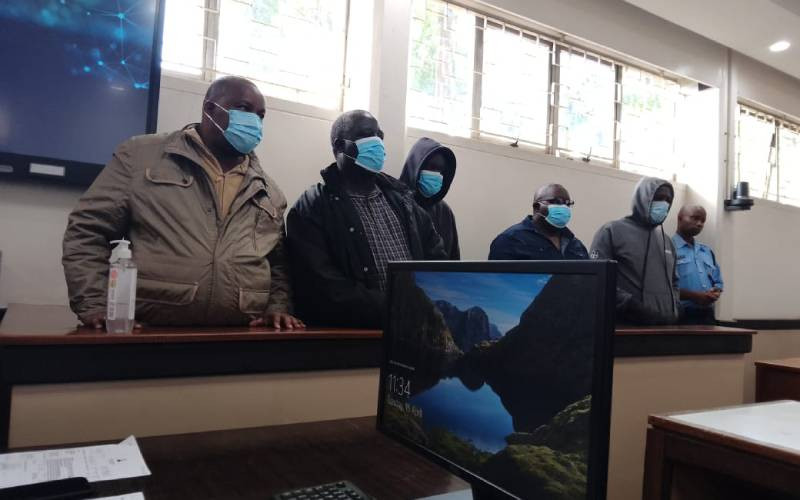 |
|
Paulo Leocardia vividly recalls the killing of locals by white settlers. [PHOTOS: TITUS MUNALA/STANDARD] |
By ABENEA NDAGO
Despite tourism being at the nerve centre of the country’s economy, the Government lacks proper documentation of the country’s attraction sites.
According to the collections manager at the Kenya National Museum (palaeontological section) Francis Nderitu Muchemi, Kenya has more than 50 attraction sites. However, there is scant documentation on specific circumstances under which each site was founded.
“Ideally, information ought to come either from a researcher, or the general public,” says Ms Jane Gitu, a research scientist at Kenya National Museums (sites and monuments department).
But a specific case of Songhor site in Nyanza’s Nyando District offers an intriguing window into the secret story of some of Kenya’s sites.
Martin Pickford’s Kenya Palaeontological Gazetteer, Volume 1 – Western Kenya (1984) reads: “Leakey and McInnes discovered a very rich site at Songhor in 1932, which was worked several times by the East African Archaeological Expedition… The British Kenya Miocene Expedition made several extensive collections at Songhor in 1947, 1948, 1949, 1950, and 1958.”
Gazetted by Njonjo
Records show that the 78-acre Songhor site was then gazetted by the then Constitutional and Home Affairs Minister Charles Njonjo in Kenya Gazette Notice No 2210 of July 24 1981, and confirmed through Kenya Gazette Notice No 1517 of June 14, 1982.
But neither Louis Leakey nor McInnes lived anywhere near Songhor. So who told the two about the site? Mr Muchemi doubts that the information came from Africans who lived in Songhor at the time.
“First,” he explains, “1932 was too early for any trusting friendship between Africans and white people. Second, I do not think Africans knew the importance of fossils anyway.”
A clue to the possible origins of Songhor site is Mr Paulo Leocardia, a crippled old man who appears to have a rich experience living around the site.
Born in Iberenya village of Kisa in Western in the 1930s, Leocardia recalls that he came to Songhor in 1951, and this is where he still lives, in a small room near Songhor Primary School. Before then, he had been a driver for Italians who lived in Nandi Hills town.
“Songhor was a place for white people, and Africans who worked for them,” he says. The settlement scheme lies several kilometres north-east of Chemelil Sugar Company.
Mathew Ouma Ogwang’, a retired teacher who arrived in Songhor in the 1960s recalls that 1963 was the year the settlement scheme was demarcated and then bought by people who had paid Sh120.
“This place was bush from horizon to horizon,” he says. “White people had kept cattle and pigs.”
Stay informed. Subscribe to our newsletter
Collective memory
Mr Ouma recalls that when people finally settled in 1965, the myth of Kachinja (slaughter me), Kachama (eat me), or Katoka (the back of my head) was already intact in the people’s collective memory.
Even today, the myth still lives on in the whole sugar-belt stretching from Owiro to Kimwani, Mberere, Songhor, Tamu, Chemelil, Oduwo, Koru, Fort Tenan, and Awasi.
The Kachinja myth describes a breed of strange people who slaughtered and ate Africans in the colonial days. “The rumour was so real that some who had bought land resold it to the brave,” says Ouma.
“That was how I got my piece of land – by buying from someone who was fleeing. These Kachinja were rumoured to suck people’s blood using a special needle. Sometimes they ate your tender organs.”
At 25 years in 1965, Remjius Anditi of Odiyo Wang’e Village in Songhor was way younger. His parents left Nyamware village in West Kano, near Alendu, and they travelled to Songhor. He says the endless wilderness confounded his eyes.
“I remember three white men,” he recalls. “The one who used to live in the land that was later bought by Isabella Abura was nicknamed Abang’a by the Luo. Then there was another, nicknamed Osiro. He was the owner of the land bought by Mr Owino.” Owino was one of the earliest Luo Provincial Commissioners, while Abura was a villager.
“Near the museum, there was a white man called Meclaus. It was said that he slaughtered people and took their blood. I have seen the hole where he was doing all this,” claims Anditi. He says he knew of Mr ‘Mek’ and his activities through a Mr Kipsaina, who used to work for the white man, but who has since died.
Wilkista Odeny, a local, recalls that when they came from Nyakach in 1965, the place was rife with rumour about a big hole near the museum, where people used to be slaughtered.
“We used to fear a lot when we heard that people were being slaughtered. Rumour was everywhere. It was a sad monument for people around here,” she recalls.
This writer remembers an occurrence in Songhor, around 1983, when his neighbour’s daughter (she is alive but blind) had her eyes gouged out by someone who was never caught, as she walked back home from school one late rainy evening. Songhor shook palpably, and pupils were warned to walk in groups.
Leocardia says there were white men who used to slaughter Africans in Songhor, and they lived near Songhor site. He found the slaughter ongoing when he arrived in 1951.
“But I did not see Tom and Mek eat the bodies of their victims. They said they were going to make drugs.”
Near the Songhor site, there is a dark, underground room whose sheer architecture leaves no doubt as to the occurrence of such an atrocity. The builder must have had a definite motive.
Today, safely hidden in someone’s compound, the room has a small door, and an air hole.
“The name of the first mzungu (white man) who owned the home was Tom,” Leocardia recalls. “He sold it to Mek towards independence.”
The old man says that Songhor was then a small gathering of churches, and nearby, there was an Indian who owned four lorries. Each evening, around 4pm, some white men who lived in Tom and Mek’s compound accompanied Leocardia to the Indian’s, where they borrowed one lorry “to carry stones”.
“Tom and Mek told me not to reveal to the Indians the work of the lorries, lest they slaughter me,” Leocardia says.
Out on the roads
For a whole evening, Leocardia drove the lorry, stretching till around 8:30pm and he stopped occasionally to allow the white people to pounce on Africans, who were still wandering on the roads.
“I stopped the lorry whenever we saw someone walking. The white people pretended that they were policemen. On a good evening, we arrested even 10 people. Then I would drive the lorry back home.”
In Tom and Mek’s compound, Leocardia remembers that the first ritual was injecting the captives with strong medicine, which made them lose awareness. Then they were herded into the dark, underground room.
“They lived in the hole for 14 days. They were given some food. But on the 15th day, one Indian and two Africans cut their necks and opened their stomachs with long knives to take away some organs. The rest of the body was thrown where the museum is.”
Is it these white men who led Leakey and McInnes to Songhor site in 1932? At the National Archives, records show that LSB Leakey worked with the CID as the Officer-in-Charge of African Intelligence Section from September 1 1939 to July 11 1945 (Ref No NM/1/679). The exact origins of the Songhor site of the National Museum will remain steeped in mystery. Samuel Ogalo, the Chief of Tamu Location, where the site is found, says he is unaware of any such killings in the past.
 The Standard Group Plc is a
multi-media organization with investments in media platforms spanning newspaper
print operations, television, radio broadcasting, digital and online services. The
Standard Group is recognized as a leading multi-media house in Kenya with a key
influence in matters of national and international interest.
The Standard Group Plc is a
multi-media organization with investments in media platforms spanning newspaper
print operations, television, radio broadcasting, digital and online services. The
Standard Group is recognized as a leading multi-media house in Kenya with a key
influence in matters of national and international interest.
 The Standard Group Plc is a
multi-media organization with investments in media platforms spanning newspaper
print operations, television, radio broadcasting, digital and online services. The
Standard Group is recognized as a leading multi-media house in Kenya with a key
influence in matters of national and international interest.
The Standard Group Plc is a
multi-media organization with investments in media platforms spanning newspaper
print operations, television, radio broadcasting, digital and online services. The
Standard Group is recognized as a leading multi-media house in Kenya with a key
influence in matters of national and international interest.









